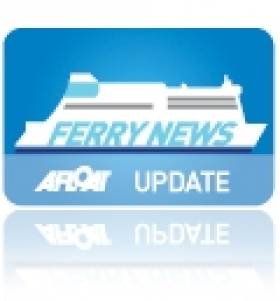Displaying items by tag: Cammell Laird,Birkenhead
Channel Islands Ferry Has Technical Fault After Entering Service Sees Ship Go to Irish Sea for Dry-Docking
UK-Channel Islands operator, Condor Ferries' newly introduced ropax, Condor Islander, is out of service due to technical problems that took place just three days after its first passenger sailing.
The stern vehicle loading only ferry which was acquired from a New Zealand operator, arrived to St. Peter Port, Guernsey from the UK on Sunday 22 October, the day of its maiden passenger sailing.
The Dutch built ropax was unable to continue on to St. Helier, Jersey but returned to Portsmouth instead.
ITV News understood there is an issue with the ferry's bow thrusters (see symbol on bow of above photo) that led to sailings between Thursday 26 October and tomorrow’s, Thursday 2 November being cancelled.
Afloat.ie today (1 November) can confirm Condor Islander is off service, as the ropax vessel departed last Thursday bound for the Irish Sea where the ferry arrived two days later and is currently in dry-dock at Cammell Laird, Birkenhead.
The 125m long 400 passenger ferry with more than 1,200 freight lane metres, was in April acquired from New Zealand operator StraitNZ with the help of a £26 million loan from the States of Guernsey.
When approached by ITV News, a spokesperson for Condor Ferries declined to comment on the disruption which continues as Afloat adds with this week’s Storm Ciarán.
According to the operators’ facebook sailing update, it has been necessary to cancel conventional and fast-craft crossings today.
First Ferry in 60 Years for Mersey River Expected to be Built at Birkenhead Shipyard
A project to build a new Mersey ferry in more than 60 years has been announced by the Mayor of Liverpool City Region.
The Mayor, Steve Rotheram said that the multi-million pound project will "ensure that the iconic 'Ferry Cross the Mersey' will continue to be enjoyed by generations to come."
According to ITV News, the new ferry is expected to be constructed at the historic Cammell Laird shipyard located in Birkenhead, opposite of Liverpool's famous Three Graces waterfront which includes the former Cunard Line building.
The work at the shipyard on the Wirral Peninsula would support jobs, apprenticeships and development opportunities for the region in north-west England.
Steve Rotheram said: "The Mersey Ferries are not only a vital transport link between communities in the Liverpool City Region, they're also an important part of our identity.
"But, as the current vessels are older than the Gerry and the Pacemakers song that helped make them world famous, they are becoming harder and harder to maintain and definitely in need of an upgrade.
"There have been boats crossings the Mersey since the 12th century and, thanks to our investment, here they’ll stay…"
Following a consultation process in 2018, feedback received has led to a design which will provide passengers with greater comfort and improved accessibility so to enhance the overall experience on the service operated by MerseyTravel.
More here on the ferry service which Afloat adds is currently served by the Cammell Laird's 1960 built Royal Iris of the Mersey (see ex Mountwood's Dun Laoghaire role) which runs the commuter service in addition to River Explorer Cruises.
Another veteran ferry, the Snowdop (known as the Dazzle ferry) is out of service. The former Woodchurch also from the shipyard in Birkenhead, in more recent years was repainted in an eye-catching design in honour of the 'camouflage dazzle' patterns that were first used on vessels in World War One.
UK Shipyard Lands Biggest Civil Shipbuilding Project in a Generation
#BiggestContract - The Telegraph writes that Cammell Laird on Merseyside has beaten off foreign rivals to land a £200m project to build an advanced research ship for British Antarctic Survey.
Britain’s martime industry has been given a major boost with Cammell Laird landing the biggest commercial shipbuilding contract in more than a generation.
The Merseyside yard beat off competition from rivals in Europe and the Far East to win a £200m deal to build an advanced polar research ship for the Government-backed British Antarctic Survey (BAS).
Work will begin cutting steel for the new 410ft long vessel in autumn 2016 with the ship ready to go into service in 2019, cementing Britain’s position as a world leader in polar science. The project is expected to secure 400 jobs at Cammell Laird and a further 100 positions in the supply chain.
For much more on this newbuild contract, the newspaper reports here.
Earlier this year on Afloat.ie it was reported that Cammell Laird was awarded a contract for a £5.7m project by Northern Ireland's Department for Regional Development.
The contract is for a car-ferry on the Strangford Lough service which will replace an ageing ferry. A second ferry was also on the cards for the service to Rathlin Island.
Ferry Changes on Dublin-Isle of Man Route
#FERRY NEWS- This weekend's round-trip Douglas-Dublin sailings are to be served by fast-ferry Manannan (1998/5,743grt) instead of conventional ferry, writes Jehan Ashmore.
Usually these winter sailings are operated by Ben-My-Chree (1998/12,504grt), as the Dutch built ro-pax is in dry-dock at Cammell Laird, Birkenhead for repairs to her bow-thruster.
The InCAT built Manannan will cover these sailings with an arrival in Dublin Port this evening at 22.00hrs. She spends a short-around in port lasting only 45 minutes, before returning to the Manx capital.





























































